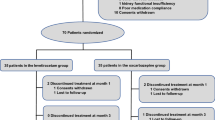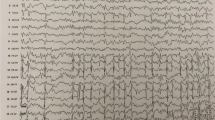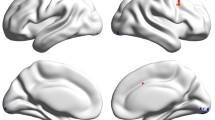Abstract
Purpose
Epilepsy and migraine frequently show a clinical overlap. An increase in number of electroencephalographic abnormalities, such as centro-temporal spikes (CTS), may be observed in patients suffering from migraine, epileptic abnormalities that are typically in benign epilepsy of childhood with CTS (BECTS). The aim of this study is to better define the role of CTS in children with migraine compared to children with BECTS, in relation with their neuropsychological profile.
Methods
Thirty-two children were enrolled and divided into three groups on the basis of their diagnosis: 16 children (eight males and eight females, aged 12.3 ± 2.58 years) affected by BECTS, 8 patients (four males and four females, aged 11.8 ± 3.47 years) affected by BECTS and migraine, and 8 children (four males and four females, aged 13.5 ± 1.79 years) affected by migraine showing CTS abnormalities. A cognitive and neuropsychological assessment was performed, using Wechsler Intelligence Scale for Children—third edition and NEPSY II, in all patients.
Results and conclusions
A similar neuropsychological impairment was found in patients affected by BECTS and in those affected by BECTS and migraine; a significant deficit in short- and long-term verbal memory was evident in patients affected by migraine and CTS. CTS in patients with migraine can influence the neuropsychological tests, with a possible negative impact on language and learning development.
Similar content being viewed by others
References
Bigal ME, Lipton RB, Cohen J, Silberstein SD (2003) Epilepsy and migraine. Epilepsy Behav 4(suppl 2):13–24
Bianchin MM, Londero RG, Lima JE, Bigal ME (2010) Migraine and epilepsy: a focus on overlapping clinical, pathophysiological, molecular, and therapeutic aspects. Curr Pain Headache Rep 14:276–283
Verrotti A, Coppola G, Di Fonzo A et al (2011) Should “migralepsy” be considered an obsolete concept? A multicenter retrospective clinical/EEG study and review of the literature. Epilepsy Behav 21:52–59
Verrotti A, Striano P, Belcastro V, Matricardi S, Villa MP, Parisi P (2011) Migralepsy and related conditions: advanced in pathophysiology and classification. Seizure 20:271–275
International Headache Society (2004) The international classification of headache disorders: 2nd edition. Cephalalgia 24(suppl 1):9–160
Parisi P (2009) Why is migraine rarely, and not usually, the sole ictal epileptic manifestation? Seizure 18:309–312
Belcastro V, Striano P, Kasteleijn-Nolst Trenité DGA, Villa MP, Parisi P (2011) Migralepsy, hemicrania epileptica, post-ictal headache and “ictal epileptic headache”: a proposal for terminology and classification revision. J Headache Pain 12:289–294
Pietrobon D (2010) Biological science of headache channels. Handb Clin Neurol 97:73–83
Sand T (2005) Electroencephalography in migraine: a review with focus on quantitative electroencephalography and the migraine vs. epilepsy relationship. Cephalalgia 23(suppl 1):5–11
Panayiotopoulos CP (1999) Elementary visual hallucinations, blindness, and headache in idiopathic occipital epilepsy: differentiation from migraine. J Neurol Neurosurg Psychiatry 66:536–540
Piccinelli P, Borgatti R, Nicoli F, Calcagno P, Bassi MT, Quadrelli M, Balottin U, Rossi G, Lanzi G, Balottin U (2006) Relationship between migraine and epilepsy in pediatric age. Headache 46:413–421
Melchionda D, Verrotti A, Chiarelli F, Domizio S, Sabatino G, Mucedola T, D’Andreamattaeo G, Toma L, Di Iorio A, Onofrj M (1999) Headache in children with centrotemporal spikes. Neurophysiol Clin 29:90–100
Tombul T, Anlar O, Caksen H (2006) Comparison of epileptic and nonepileptic cases with centrotemporal spikes in view of clinical findings and electroencephalographic characteristics. Int J Neurosci 116:299–313
Medeiros LL, Yasuda C, Schmutzler KMR, Guerriero MM (2010) Rolandic discharges: clinico-neurophysiological correlation. Clin Neurophysiol 121:1740–1743
Buodo G, Palomba D, Sarlo M, Naccarella C, Battistella PA (2004) Auditory event-related potential and reaction times in migraine children. Cephalalgia 24:554–563
Riva D, Aggio F, Vago C, Nichelli F, Andreucci E, Paruta N, D’Arrigo S, Pantaleoni C, Bulgheroni S (2006) Cognitive and behavioural effects of migraine in childhood and adolescence. Cephalalgia 26:596–603
Parisi P, Verrotti A, Paolino MC, Urbano A, Bernabucci M, Castaldo R, Villa MP (2010) Headache and cognitive profile in children: a cross-sectional controlled study. J Headache Pain 11:45–51
Commission on Classification and Terminology of the International League Against Epilepsy (1989) Proposal for revised classification of epilepsies and epileptic syndromes. Epilepsia 30:389–399
Bali B, Kull LL, Strug LJ, Clarke T, Murphy PL, Akman CI, Greenberg DA, Pal DK (2007) Autosomal dominant inheritance of centrotemporal sharp wave in rolandic epilepsy families. Epilepsia 48:2266–2272
Shields WD, Snead OC 3rd (2009) Benign epilepsy with centrotemporal spikes. Epilepsia 50(suppl 8):10–15
Danielsson J, Petermann F (2009) Cognitive deficits in children with benign rolandic epilepsy of childhood or rolandic discharges: a study of children between 4 and 7 years of age with and without seizures compared with healthy controls. Epilepsy Behav 16:646–651
Calandre EP, Bembibre J, Arnedo ML, Becerra D (2002) Cognitive disturbance and regional cerebral blood flow abnormalities in migraine patients: their relationship with the clinical manifestation of the illness. Cephalalgia 22:291–302
Farmer K, Cady R, Bleiberg J, Reevers D (2000) A pilot study to measure cognitive efficacy during migraine. Headache 40:657–661
Suhr JA, Seng EK (2012) Neuropsychological functioning in migraine: clinical and research implications. Cephalalgia 32(suppl 1):39–54
Seidel S, Hartl T, Weber M, Matterey S, Paul A, Riedel F, Gharabaghi M, Wober-Bingol C, Wober C, PAMINA Study Group (2009) Quality of sleep, fatigue and daytime sleepiness in migraine—a controlled study. Cephalalgia 29:262–269
Conflict of interest
None of the authors has any conflict of interest to disclose. We confirm that we have read the journal’s position on issues involved in ethical publication and affirm that this report is consistent with those guidelines.
Author information
Authors and Affiliations
Corresponding author
Rights and permissions
About this article
Cite this article
Parisi, P., Matricardi, S., Tozzi, E. et al. Benign epilepsy of childhood with centro-temporal spikes (BECTS) versus migraine: a neuropsychological assessment. Childs Nerv Syst 28, 2129–2135 (2012). https://doi.org/10.1007/s00381-012-1867-9
Received:
Accepted:
Published:
Issue Date:
DOI: https://doi.org/10.1007/s00381-012-1867-9




